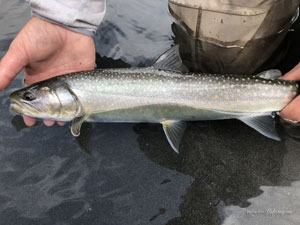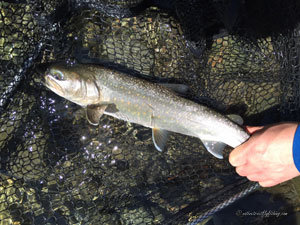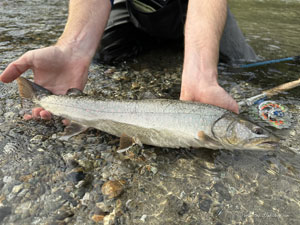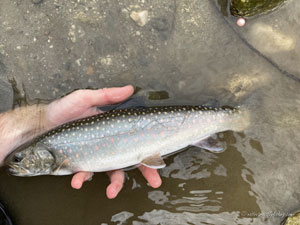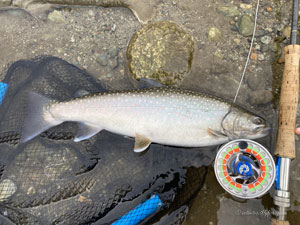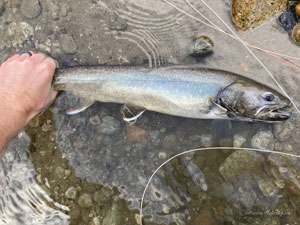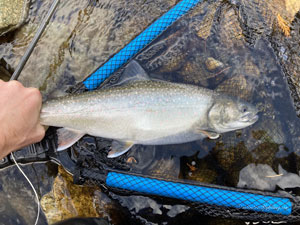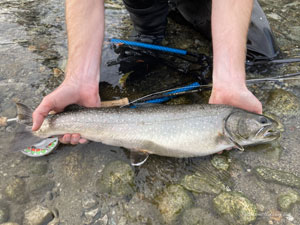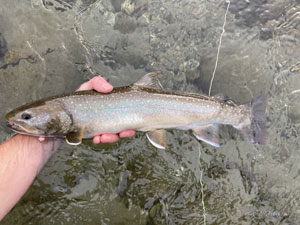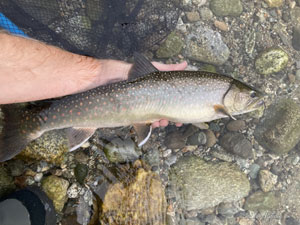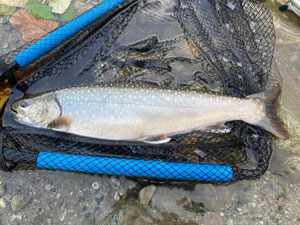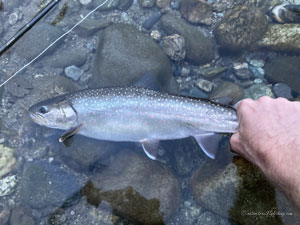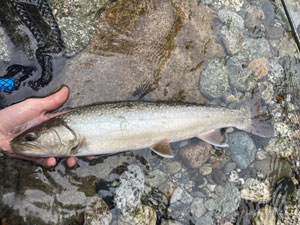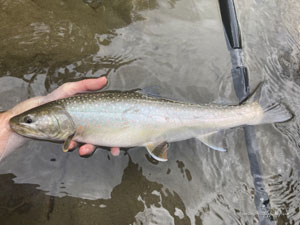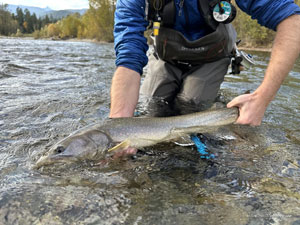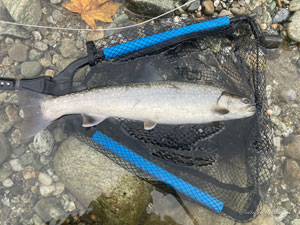Coastal Bull Trout
Salvelinus confluentus confluentus
An adfluvial bull trout from an Olympic Peninsula stream.
Introduction
Bull trout have a large native range, spanning from Northern California to the headwaters of the Yukon River in Canada. Throughout much of their range these char are the top predator, with a voracious appetite diet consisting primarily of other fish, bulls are able to attain weights of 30lbs or more under the right conditions. However bull trout require cool, clean water and are the first fish to disappear from heavily exploited watersheds. As such bull trout have become exceedingly rare across much of the west and careful protection is required to ensure the continued existence of these beautiful char.
Life History Information
Bull trout are a rather specialized and highly predatory species of char and may display stream resident, fluvial, lacustrine (adfluvial) or anadromous life histories. Resident bull trout are typically found in smaller or the upper reaches of rivers streams and often times only travel a few hundred yards during their life time (Moore 2006). Stream resident and juvenile bull trout have a diet similar to trout, consisting primarily of aquatic insects, but bulls tend to feed much more subsurface. Resident bull trout tend to be found in the coolest upper reaches up stream and under these conditions growth is slow and these bulls may only reach sizes of 6" to 12" in their lifetime. While fluvial bull trout typically spawn and rear in the headwaters of rivers or smaller streams, they also make extensive migrations into larger river systems. Once large enough, these fluvial bull trout feed almost exclusively on other fish such as juvenile salmonids and forage fish like sculpin. However like other char bulls are opportunistic and will feed on other items such as mice, frogs, salmon flesh and eggs when available (Fish 2004). Mountain whitefish are the most important forage fish across their native range with some interior populations feeding almost exclusively on whitefish. Throughout their life, bull trout prefer deeper pools, with good cover, but they typically move into to shallower and slower water at night to feed (Al-Chokhachy and Budy 2007). Like all char, bulls are fall spawners and spawning takes place between September and December depending on temperature and the location of the stream. Fluvial and stream resident populations generally spawn in the same areas, but the redds of resident fish are typically much smaller (Bellerud et al. 1997). Redds are most common in areas of downwelling in a stream, where there is a high flow of water through the gravel (Baxter and Hauer 2000). This high flow of water through the redds helps keep the eggs cool and well oxygenated and optimum conditions for egg survival occur at around 35 to 39°F. Eggs are may take around 220 days to hatch and fry often do not emerge for the gravel for another two or three months (Fish 2004). Interior populations often have two different spawning runs, with one comprised of two and three year old fish that migrate upstream during spring run off and another of three and four year old fish that migrate upstream in the fall (Bellerud et al. 1997).
The largest bull trout are those coming from lacustrine populations, especially those from lakes also containing kokanee salmon. While brook and lake trout are often able to spawn in the lakes themselves, lacustrine bull trout are adfluvial and require moving water to spawn. Juveniles from lacustrine populations may spend as little as a few months or as much as four years rearing in the stream before migrating to the lake. Downs et al. (2006) showed that young of year bull trout migrating to Lake Pend Oreille had extremely low survival rates to their first spawning event. This study showed that the bulk of first time spawners had reared in their natal stream for three to four years. Juveniles make their first migration to the lake either during the high spring flows or once the cooler fall water temperature set in. Once in the lake environment, bull trout feed on smaller fish, aquatic insects and other invertebrates but their diet becomes increasing comprise of fish as they get larger. On this diet bull trout may grow up to 12" each year and fish over ten pounds are not uncommon from these populations. When present, kokanee typically represent the largest contributor to the bull trout's diet, but other salmonids including rainbow trout, cutthroat, whitefish, salmon fry and even juvenile bull trout are also important. In Lake Billy Chinook, OR when other forage fish populations are low, adult bull trout may consume between 19% and 44% of the young of year bull trout in the lake (Beauchamp and Van Tassell 1999). Some lacustrine populations may make extensive migrations to reach their spawning grounds and one populations from Lake Pend Oreille is known migrate down the Pend Oreille River and then up two tributaries a distance of over 50 miles (DuPont et al. 2007). Fish from Flathead Lake in Montana, may travel as far as 150 miles up the Flathead River and its tribuataries to reach their spawning grounds (Fraley and Shepard 1989). Although their is a wide range in run timings across their range most fish begin their migrations in either the spring or fall. Lacustrine populations in the Olympics may move into the rivers as early as June to feed but the actual spawning does not begin until October and continued through December (Brenkman 2001).
Until recently very little was known about the anadromous form of bull trout, however recent studies have indicated that these sea-going bull trout lead a highly migratory and complex life history. Accordding to Goetz et al. (2004) anadromous populations of bull trout have a native range from 46°N to 56°N along the Pacific coast, whereas anadromous Dolly Varden range from 50°N to 71°N. Anadromous bull trout from the Hoh River migrate into marine waters at an age of between three to six years old and at a length of around 12" (Brenkman et al. 2007). However those from the Skagit River have been shown to migrate to marine waters during their second year of life and at sizes of four to twelve inches (Zimmerman and Kinsel 2010). Once in marine waters bulls feed heavily on forage fish and those from the Puget Sound, feed primarily on sand lance, surf smelt, juvenile salmon and shiner perch. Anadromous bull trout from the Skagit River watershed overwinter in freshwater and primarily migrate to marine waters during the time period between April and August. As fall approaches, these fish follow the salmon into the river to feed on eggs and flesh and then spawn during the months of October and November. In contrast bull trout from the Hoh River on the Olympic Peninsula have been shown to overwinter in marine waters and migrate into freshwater from May to July (Brenkman and Corbett 2005). These bull trout also were found to use the saltwater to travel between watersheds and several fish from the Hoh River have also been found in the Queets and Quinault basins to the south.
Status
Bull trout have experienced large scale declines across much of their native range, especially in the United States, where they are currently listed as threatened under the Endangered Species Act. Being a predatory fish, bull trout typically occur at much lower population levels than other salmonids making them the first fish to disappear from imperiled watersheds. This is compounded by the fact that bulls are extremely susceptible to habitat degradation as they require clean cold water for survival. An example of this is the loss of the southernmost bull trout population in the McCloud River. With the construction of Shasta Dam, anadromous fish were cut off from the upper McCloud River and the bulls lost a vital food source. Given that the waters of Shasta Lake were also too warm for bull trout survival, this population was unable to take advantage of the lacustrine environment and quickly disappeared. In contrast many northern populations have simply adapted to a lacustrine life history with the construction of dams and often thrive in the new reservoirs. Poor logging practices are particularly detrimental to the survival of bull trout populations. Bull trout eggs are extremely susceptible to suffocation due to sedimentation. Being as bull trout require cool temperatures for survival the removal of riparian vegetation this is the most detrimental to juveniles that cannot survive temperatures over 65°F (Selong et al. 2011). Today most bull trout populations are restricted to remote and intact drainage and fishing for these char is highly regulated or not allowed across much of the western United States.
As with other salmonids the introduction of non-natives has been problematic for bull trout and in particular brook trout and lake trout have the greatest impacts. Although Dolly Varden also occur naturally in the same waters as bull trout, hybrids appear to be vary rare and the two species have been able to maintain distinct genomes. However introduced brook trout hybridize with bull trout rather commonly where they have been introduced and pose a serious threat to bull trout. This hybridization generally occurs when the larger male bull trout drive the smaller male brookies away to spawn with a female brook trout (Behnke 2002). Beyond the threat of hybridization, Gunckel et al. (2002) showed that when resources are limited juvenile brook trout tend to grow quicker than juvenile bull trout and dominate the best holding a feeding water. While lake trout are not know to present a hybrid threat to bull trout, they are fierce competitors and can greatly limit the feeding opportunities of bull trout. The examples of Bow and Hector lakes in southern Alberta, where lake trout were stocked in 1964 and by the time the lake was sampled in 1992 no bull trout could be found (Donald and Alger 1993). Given that bull trout themselves often limit their own populations via cannibalism on juveniles, it is likely that the combination of competition and falling prey to lake trout is too much pressure to allow bull trout populations to survival. It can be hoped that with more enlightened logging and stocking practices that bull trout will begin to make a comeback across their native range.
Description
Bull trout are often confused with Dolly Varden where to two species' native ranges overlap and at times genetic analysis has to be used to differentiate these fish. In comparison to Dolly Varden, bull trout have a larger and broader head and their jaw is longer and extends much further their eyes then Dolly Varden. Bull trout also tend to have a smaller adipose fin and a more squared off tail then Dolly Varden. The coloration of bull trout is somewhat variable from population to population, but they are generally a gray to brown or olive-brown color along their backs and sides. However lacustrine and anadromous populations may be rather silvery in coloration until spawning approaches. Spawning bull trout often attain a yellow or orangish-red color along their bellies, a trait that is particularly common in males. Males also develop a kype as spawning approaches and the jaw coloration may take on a yellowish hue during this time period. The spots on bull trout are primarily a white or cream color, but pink, red or orange spots may be present along the sides. The lower fins may be a dark gray to a brownish-orange color and the fins tipped with a white and black line.
Stream Resident Form
Click on images to view a larger picture
Native Range
A map of the native range of the Bull trout. Data Source: Behnke (2002).A map of the native range of the Coastal (Yellow) and Interior (Orange) lineages of Bull Trout. Data Sources: Taylor et al. 1999, Haas and McPhail 2001, Post and Johnston 2002, Reist et al. 2002, Mochnacz et al. 2004, Mochnacz et al. 2013, Bohling et al. 2019.
References
Al-Chokhachy, R. and P. Budy. 2007. Summer microhabitat use of fluvial bull trout in eastern Oregon streams. North American Journal of Fisheries Management 27:1068–1081.
Baxter, C.V. and F.R. Hauer. 2000. Geomorphology, hyporheic exchange, and selection of spawning habitat by bull trout (Salvelinus confluentus). Canadian Journal of Fisheries and Aquatic Sciences 57(7): 1470-1481.
Bellerud, B.L., S. Gunckel, A.R. Hemmingsen, D.V. Buchanan and P.J. Howell. 1997. Bull trout life history, genetics, habitat needs, and limiting factors in Central and Northeast Oregon. Bonneville Power Administration, Portland, OR. Project Number 95-54.
Beauchamp, D.A. and J.J. Van Tassell. 1999. Modeling seasonal trophic interactions of adfluvial bull trout in Lake Billy Chinook, Oregon. Pelton Round Butte Hydroelectric Project, FERC No. 2030. Portland General Electric Company, Portland, OR.
Behnke, R.J. 2002. Trout and Salmon of North America. Chanticleer Press, New York.
Brenkman, S.J., G.L. Larson and R.E. Gresswell. 2001. Spawning migration of lacustrine-adfluvial bull trout in a natural area. Transactions of the American Fisheries Society 130:981–987.
Brenkman, S.J. and S.C. Corbett. 2005. Extent of anadromy in bull trout and implications for conservation of a threatened species. North American Journal of Fisheries Management 25:1073–1081.
Brenkman, S.J., S.C. Corbett and E.C. Volk. 2007. Use of otolith chemistry and radiotelemetry to determine age-specific migratory patterns of anadromous bull trout in the Hoh River, Washington. Transactions of the American Fisheries Society 136: 1–11.
Donald, D.B. and D.J. Alger. 1993. Geographic distribution, species displacement, and niche overlap for lake trout and bull trout in mountain lakes. Canadian Journal of Zoology 71(2): 238–247.
Downs, C.C., D. Horan, E. Morgan-Harris and R. Jakubowski. 2006. Spawning demographics and juvenile dispersal of an adfluvial bull trout population in Trestle Creek, Idaho. North American Journal of Fisheries Management 26:190–200.
DuPont, J.M., R.S. Brown and D.R. Geist. 2007. Unique allacustrine migration patterns of a bull trout population in the Pend Oreille River drainage, Idaho. North American Journal of Fisheries Management 27(4): 1268-1275.
Fraley, J.J. and B.B. Shepard. 1989. Life history, ecology and population status of migratory bull trout (Salvelinus confluentus) in the Flathead Lake and River system, Montana. Northwest Science 63(4): 133-143.
Goetz, F. A., E. Jeanes, and E. M. Beamer. 2004. Bull trout in the nearshore: preliminary draft report. U.S. Army Corp of Engineers, Seattle, Washington.
Gunckel, S.L., A.R. Hemmingsen and J.L. Li. 2002. Effect of bull trout and brook trout interactions on foraging habitat, feeding behavior, and growth. Transactions of the American Fisheries Society 131:1119–1130.
Haas, G.R. and J.D. McPhail, 2001. The post-Wisconsinan glacial biogeography of bull trout (Salvelinus confluentus): a multivariate morphometric approach for conservation biology and management. Canadian Journal of Fisheries and Aquatic Sciences 58: 2189-2203.
Fish. M.A. 2004. Taxonomy, ecology and life history of bull trout, Salvelinus confluentus (Suckley). University of California, Davis, California.
Haas, G.R. and J.D. McPhail, 2001. The post-Wisconsinan glacial biogeography of bull trout (Salvelinus confluentus): a multivariate morphometric approach for conservation biology and management. Canadian Journal of Fisheries and Aquatic Sciences 58: 2189-2203.
Mochnacz, N.J., J.D. Reist, P. Cott, G. Low and R. Wastle. 2004. Biological and habitat data for Bull Trout (Salvelinus confluentus) and associated species from stream surveys conducted in the southern and central Mackenzie River valley, Northwest Territories, 2000 to 2001. Fisheries and Oceans Canada, Winnipeg, MB
Mochnacz, N.J., R. Bajno, J.D. Reist, G. Low and J.A. Babaluk. 2013. Distribution and biology of Bull Trout (Salvelinus confluentus) in the Mackenzie valley, Northwest Territories, with notes on sympatry with Dolly Varden (Salvelinus malma). Arctic 66(1): 79-93.
Post, J.R. and F.D. Johnston. 2002. Status of the Bull Trout (Salvelinus confluentus) in Alberta. Alberta Sustainable Resource Development, Fish and Wildlife Division, and Alberta Conservation Association, Wildlife Status Report No. 39, Edmonton, AB. 40 pp.
Reist, J.D., G. Low, J.D. Johnson and D. McDowell. 2002. Range extension of bull trout, Salvelinus confluentus, to the central Northwest Territories, with notes on identification and distribution of Dolly Varden, Salvelinus malma, in the western Canadian arctic. Arctic 55(1): 70-76.
Selong, J.H., T.E. McMahon, A.V. Zale and F.T. Barrows. 2001. Effect of temperature on growth and survival of bull trout, with application of an improved method for determining thermal tolerance in fishes. Transactions of the American Fisheries Society 130:1026–1037.
Taylor, E.B., S. Pollard and D. Louie. 1999. Mitochondrial DNA variation in bull trout (Salvelinus confluentus) from northwestern North America: Implications for zoogeography and conservation. Molecular Ecology 8(7): 1155-1170.
Zimmerman, M. and C. Kinsel. 2010. Migration of anadromous juvenile bull trout in the Skagit River, 1990-2009. Washington Department of Fish and Wildlife, Olympia, WA.
Contact
Feel free to contact me if you have any questions or comments
Native Trout Links
California Heritage Trout Challenge
Truchas Mexicanas' - Native Trout of Mexico
Balkan Trout Restoration Group
Trout and Seasons of the Mountain Village - About Japanese Trout
Fly Fishing Blogs
Dave B's Blog: Fly Fishing for Native Trout
The Search for Native Salmonids
Conservation Links
Western Native Trout Initiative
Fly Fishing Links
Fishing Art Links
Americanfishes.com - Joseph R. Tomelleri
Fish Eye Guy - Underwater Trout and Salmon Pictures










